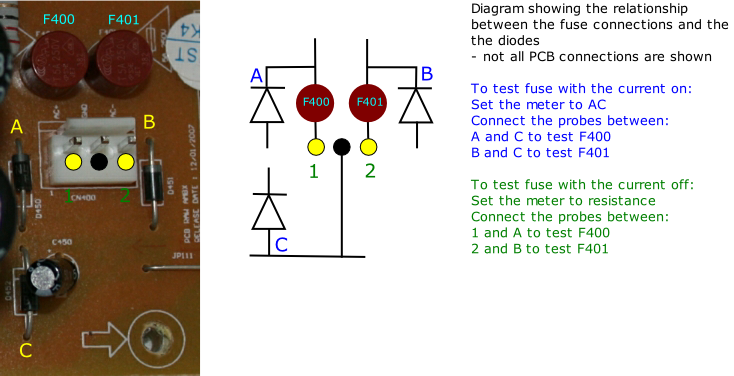Subwoofer Power Supply Unit
Description
The subwoofer connects directly to the mains supply via the fitted mains cable and plug. There is no external mains on / off switch on the subwoofer. Instead, the mains supply is switched on and off via a relay, the relay acting as a switch. See the Subwoofer and speakers / Subwoofer relay PCB page for full details of the relay and its operation.
The power supply is divided into two parts -
The regulator circuit is straight forward.
The transformer supplies a nominal voltage of 15-
The AC is rectified by bridge rectifier BD400 to give a split DC output of -
+19v6 also goes to regulator IC400 which gives a +9v DC supply.
D450, D451 and D452, provide a local DC feed.
Fig. BP1: Subwoofer power supply circuit
Testing the PSU output
The transformer rating as shown on the transformer label is 13v-
Ensure that the wallwasher is on and the relay working.
Make sure the subwoofer is connected to a live mains supply
Warning! -
The output from the PSU goes to the three pin plug (CN400) on the amplifier PCB. It may be possible to take the voltage reading for the transformer without disconnecting the plug from the PCB by putting the ends of the probes into the top of the plug (where the wires go in) as long as you don’t short out via the probe tips. If not, remove the plug and test by touching the meter probes to the bare contacts on the plug.
Set the meter to AC volts
Check the voltage across the three terminals -
This reading should be approximately the same whether the PSU is connected to the amplifier PCB or not.
If the readings are correct, it can be assumed that the the PSU is working correctly, although there is always a slight chance that the PSU may be failing under load.
Testing the on-
All DC measurements are with respect to ground -
Check that the fuses are OK as shown below.
Check for the correct voltage on the pins of bridge rectifier BD400 pins 1 and 4
Check for 9v DC output at regulator IC400 Vout pin.
Fig. BP2: Amplifier PCB fuses
Accessing the PSU
The PSU is secured to the bottom of the box by four screws which are accessed from holes in the top of the PSU.
You will need to remover the speaker grille and speaker (see the Subwoofer opening page).
Whilst one of the screws is easy to get out, you will have problems with the others, especially the back ones as the wooden top of the box blocks their access.
The screwdriver needs to go into the hole by about 10 -
I didn’t bother to attempt to remove the PSU. The only real way to gain decent access
to the screws is to drill holes in the wooden top to allow a long-
It may be possible to find a suitable replacement transformer, but it is likely to be expensive. One option is to see if you can pick up a working secondhand amBX subwoofer, or the premium system that is being sold for parts (as long as the subwoofer is working OK)
In the end, it may be better just to scrap the subwoofer and buy a new system, just keeping the speaker lights to use as lights only.
If you want to still use the amBX speakers using another amplifier, see “Connecting
a sound source to the sidelight speakers” at the bottom of the Subwoofers and speakers
/ Subwoofer an speakers -



